Unit 1 Asia 单元练习课件(共100张PPT)
文档属性
| 名称 | Unit 1 Asia 单元练习课件(共100张PPT) | 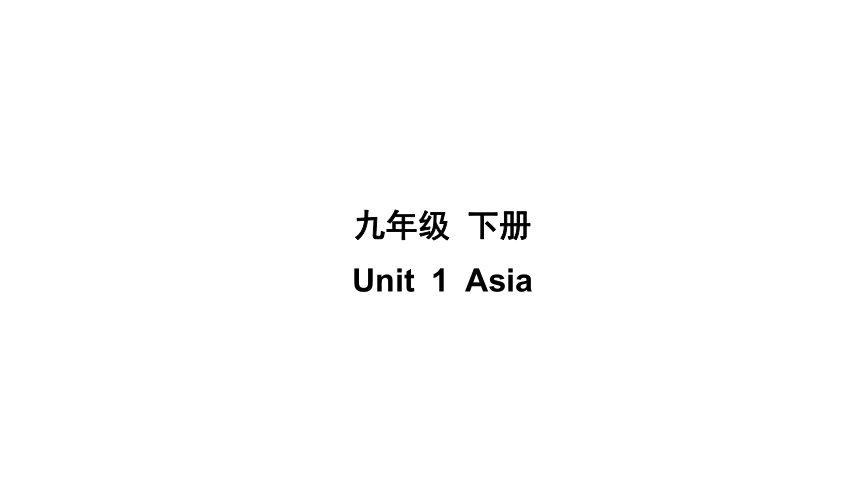 | |
| 格式 | pptx | ||
| 文件大小 | 611.2KB | ||
| 资源类型 | 教案 | ||
| 版本资源 | 牛津译林版 | ||
| 科目 | 英语 | ||
| 更新时间 | 2024-05-18 07:22:32 | ||
图片预览

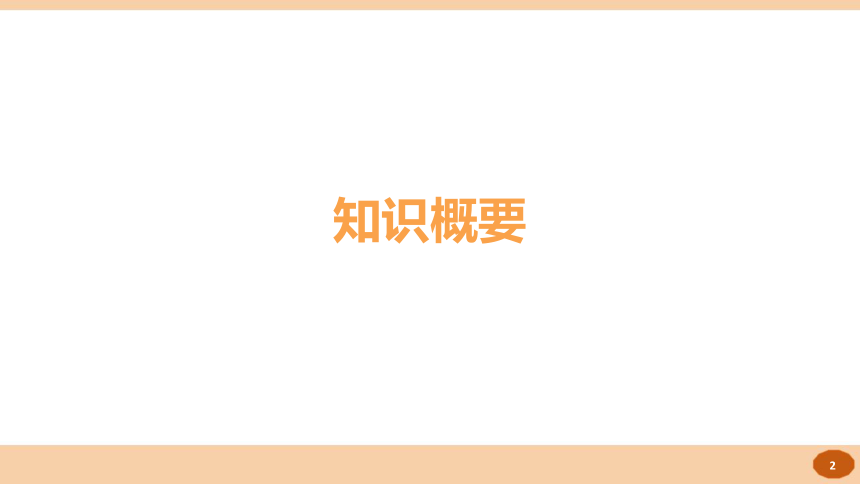
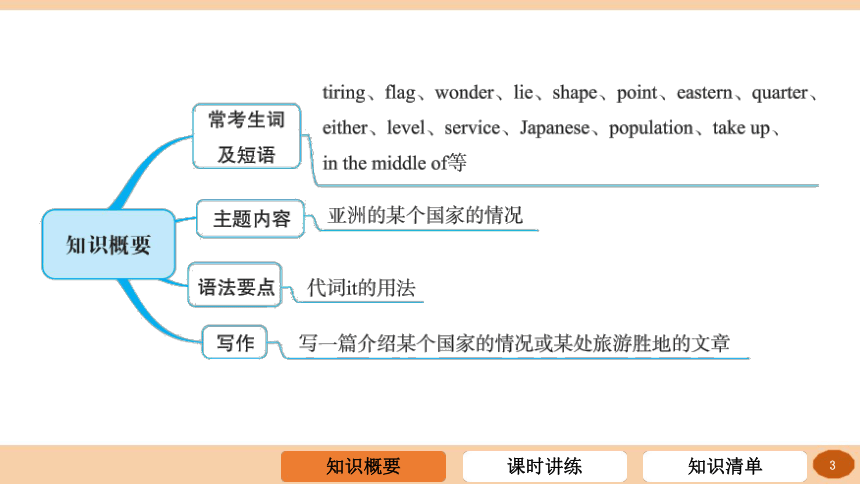

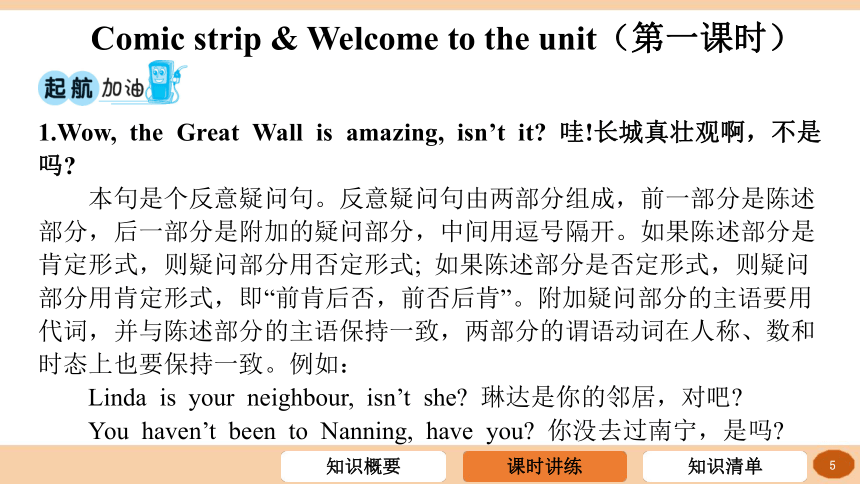

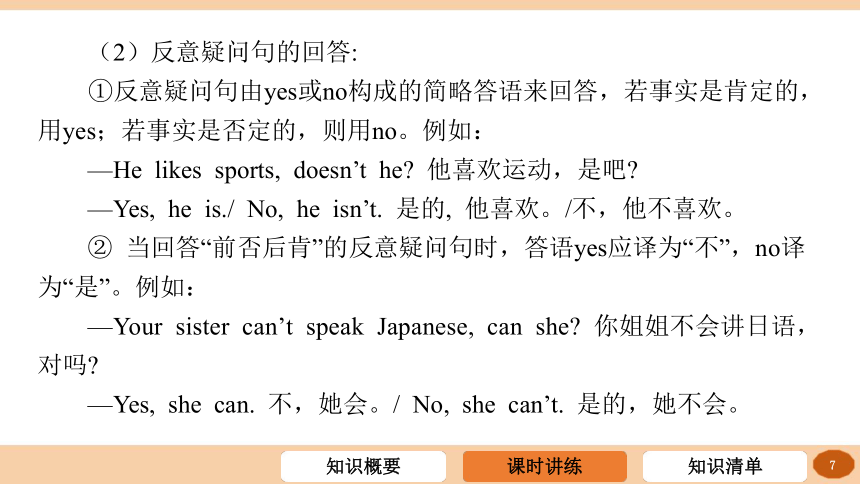
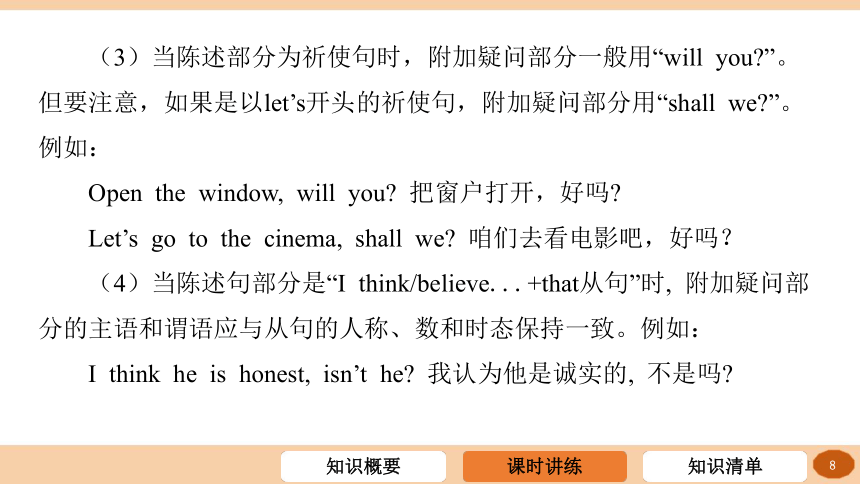
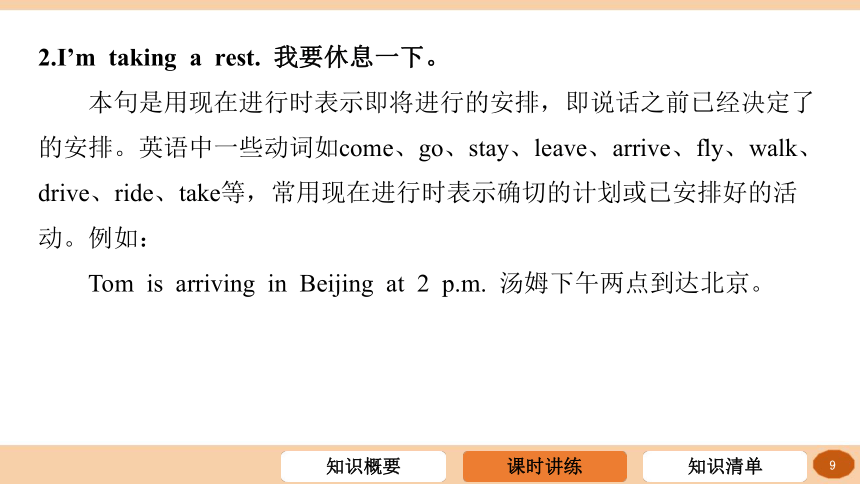
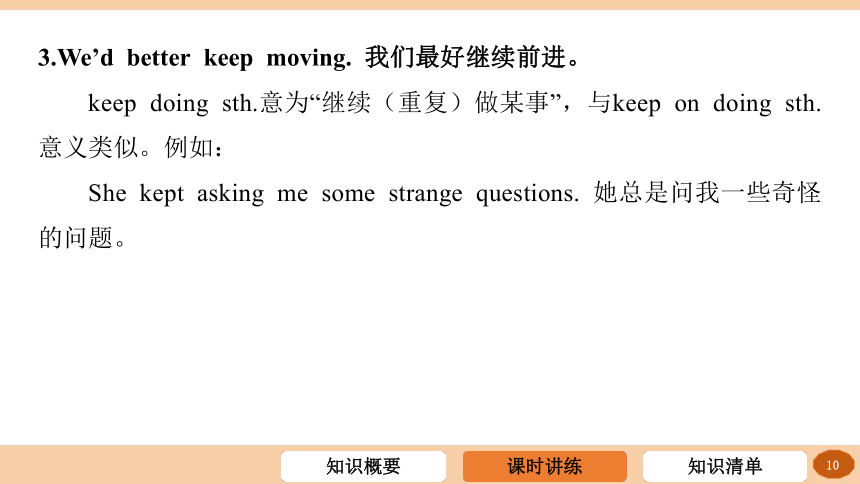
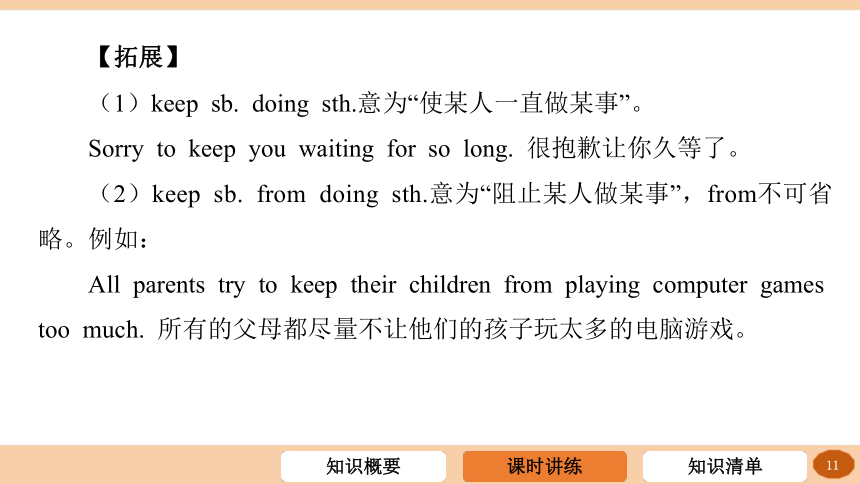
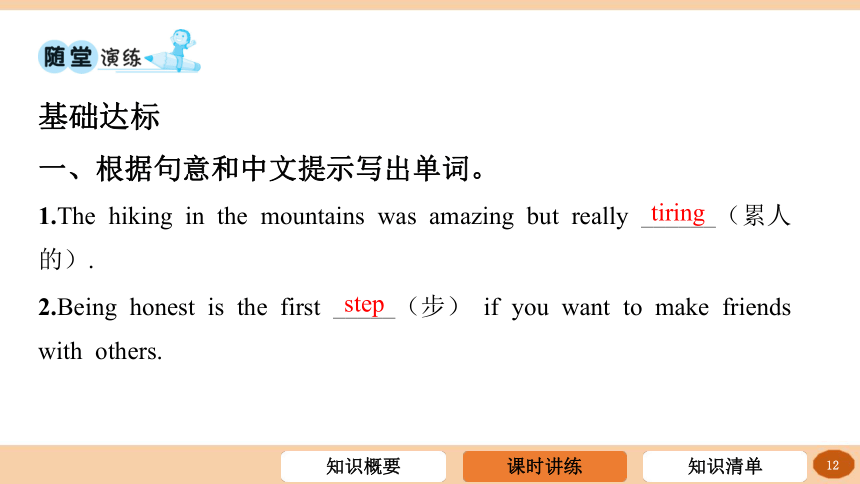
文档简介
(共100张PPT)
九年级 下册
Unit 1 Asia
知识概要
课时讲练
1.Wow, the Great Wall is amazing, isn’t it 哇!长城真壮观啊,不是吗
本句是个反意疑问句。反意疑问句由两部分组成,前一部分是陈述部分,后一部分是附加的疑问部分,中间用逗号隔开。如果陈述部分是肯定形式,则疑问部分用否定形式; 如果陈述部分是否定形式,则疑问部分用肯定形式,即“前肯后否,前否后肯”。附加疑问部分的主语要用代词,并与陈述部分的主语保持一致,两部分的谓语动词在人称、数和时态上也要保持一致。例如:
Linda is your neighbour, isn’t she 琳达是你的邻居,对吧
You haven’t been to Nanning, have you 你没去过南宁,是吗
Comic strip & Welcome to the unit(第一课时)
【拓展】
(1)反意疑问句的陈述部分含有few、little、never、seldom、nothing、nobody、none、neither、hardly等表示否定意义的词时,附加疑问部分用肯定形式。例如:
There is little water in the glass, is there 杯子子里几乎没有水,是吗
(2)反意疑问句的回答:
①反意疑问句由yes或no构成的简略答语来回答,若事实是肯定的,用yes;若事实是否定的,则用no。例如:
—He likes sports, doesn’t he 他喜欢运动,是吧
—Yes, he is./ No, he isn’t. 是的, 他喜欢。/不,他不喜欢。
② 当回答“前否后肯”的反意疑问句时,答语yes应译为“不”,no译为“是”。例如:
—Your sister can’t speak Japanese, can she 你姐姐不会讲日语,对吗
—Yes, she can. 不,她会。/ No, she can’t. 是的,她不会。
(3)当陈述部分为祈使句时,附加疑问部分一般用“will you ”。但要注意,如果是以let’s开头的祈使句,附加疑问部分用“shall we ”。例如:
Open the window, will you 把窗户打开,好吗
Let’s go to the cinema, shall we 咱们去看电影吧,好吗?
(4)当陈述句部分是“I think/believe...+that从句”时, 附加疑问部分的主语和谓语应与从句的人称、数和时态保持一致。例如:
I think he is honest, isn’t he 我认为他是诚实的, 不是吗
2.I’m taking a rest. 我要休息一下。
本句是用现在进行时表示即将进行的安排,即说话之前已经决定了的安排。英语中一些动词如come、go、stay、leave、arrive、fly、walk、drive、ride、take等,常用现在进行时表示确切的计划或已安排好的活动。例如:
Tom is arriving in Beijing at 2 p.m. 汤姆下午两点到达北京。
3.We’d better keep moving. 我们最好继续前进。
keep doing sth.意为“继续(重复)做某事”,与keep on doing sth.意义类似。例如:
She kept asking me some strange questions. 她总是问我一些奇怪的问题。
【拓展】
(1)keep sb. doing sth.意为“使某人一直做某事”。
Sorry to keep you waiting for so long. 很抱歉让你久等了。
(2)keep sb. from doing sth.意为“阻止某人做某事”,from不可省略。例如:
All parents try to keep their children from playing computer games too much. 所有的父母都尽量不让他们的孩子玩太多的电脑游戏。
基础达标
一、根据句意和中文提示写出单词。
1.The hiking in the mountains was amazing but really ______(累人
的).
tiring
2.Being honest is the first _____(步) if you want to make friends
with others.
step
3.Look! The foreigners are learning to use __________(筷子).
chopsticks
4.In many shopping malls in New York, the dragon ______(舞) is
often performed during the Chinese New Year.
dance
5.You are sure to see many _______(特别的) things in Beijing.
special
二、用括号中所给词的适当形式填空。
1.We’ll buy some Chinese ______(knot) for these exchange students.
knots
2.You had better _____(take) an umbrella with you if you go out.
take
3.The girl has an ________(amaze) ability to learn new languages.
amazing
4.They are planning ________(visit) the Palace Museum next week.
to visit
5.We need to take a little rest because there is still a long way
______(go).
to go
6.All of us should look straight ahead and keep ________(run).
running
7.—What’s wrong with you
—My head ______(hurt) a lot.
hurts
三、单项选择。
1.I ________ so early this morning, so I feel sleepy now.( )
C
A.set up B.stayed up C.woke up
2.We’d better ________ too much before doing sports.( )
B
A.not to eat B.not eat C.not eating
3.—Are you going to try out for the host of the English party
—________ It’s such a good chance to improve my spoken
English.( )
A
A.Why not B.Why me C.What’s up
4.—Lisa doesn’t like British food, ________
—No, she doesn’t.( )
B
A.is she B.does she C.doesn’t she
5.Protecting ourselves is one of ________ things we must do.( )
C
A.important B.more important C.the most important
Reading(第二、三课时)
1.With wonderful buildings and art treasures inside, it is well worth a visit. 它(故宫)里面有宏伟的建筑和艺术珍宝,非常值得一游。
(1)with后接名词构成介词短语,在句中常用作状语,表示伴随、原因、条件、时间、方式等。例如:
With a book in his hand, the teacher went into the classroom. 老师手里拿着一本书走进了教室。
(2)be worth意为“值得; 值(多少钱)”,其后常接名词或动词-ing形式,可用well修饰,表示“很值得”。例如:
Her advice is well worth taking. 她的建议很值得采纳。
This bottle might be worth ¥300. 这个瓶子可能值300元。
2.Many tourists like to gather there early in the morning to watch the raising of the national flag. 许多游客喜欢一大早聚集在那里观看升国旗仪式。
raising在此处用作不可数名词,意为“升高;增加;提高”。例如:
The raising of the price of houses made him worried then. 房价的上涨使他当时很担心。
【拓展】raise可用作及物动词,意为“提高;筹集;养育; 饲养”。例如:
He raised his head and said hello to us. 他抬起头向我们问好。
Mr. Green often raises money for charities. 格林先生经常为慈善机构筹款。
The old man raised some ducks in the yard. 那位老人在院子里饲养了一些鸭子。
3.Another famous attraction is the Great Wall. 另一个著名的吸引人的地方是长城。
(1)another在此处用作限定词,意为“又一,再一”,泛指三者或三者以上中的另一个。其后可接单数名词或“基数词(大于1)+复数名词”。例如:
I need another cup. 我还需要一个杯子。
We’ve still got another 20 miles to go. 我们还要走20英里。
【拓展】当数量大于1时,“another+基数词+复数名词”=“基数词+ more+复数名词”。例如:
They want to book another two tickets. = They want to book two more tickets. 他们想再预订两张票。
(2)【辨析】another、the other、the others、other与others
another 泛指三者或三者以上中的另一个,其后可接单数名词或
“基数词(大于1)+复数名词”,也可单独使用(此时用作
代词)
the other 表示两者中的“另一个”, 是特指,常用于“one...the
other...”结构中,表示“一个……,另一个……”。the
other之后也可接数词或复数名词,特指“其他的”,这时
other是形容词
the others 特指在一个范围内的“其他的人或物”
other 表示“别的,其他的”,后多跟复数名词
others 用作代词,泛指“其他的人或物”,与some对比使用时,表
示“一些……,其他的……”
例如:
This shirt doesn’t fit me well. Could you show me another (one) 这件衬衫不太适合我,你能给我看看另一件吗
Mum has just bought two pens. One is for me, and the other is for my sister. 妈妈刚刚买了两支钢笔,一支给我,另一张给我妹妹。
Except Alice, the others are all here. 除了艾丽丝,其余的(人)都在这里了。
Are there any other questions 还有其他问题吗?
Jim is always ready to help others. 吉姆总是乐于帮助别人。
4.It lies on the two sides of the Lijiang River. 它(桂林)位于漓江两岸。
(1)lie在此处用作不及物动词,意为“位于,坐落在”。它还可以意为“躺;说谎”。例如:
Shanghai lies in the east of China. 上海位于中国的东部。
Please don’t lie to me. 请别对我说谎。
(2)【辨析】lie与lay
原形 词义 过去式 过去分词 现在分词
lie 不及物动词 躺,位于 lay lain lying
说谎 lied lied lying
lay 及物、不及 物动词 放置,产卵,下蛋 laid laid laying
Please lie down and have a rest. 请躺下休息一会儿。
Don’t believe him. He’s lying. 不要相信他,他在说谎。
The old hen doesn’t lay eggs. 这只老母鸡不下蛋。
基础达标
一、根据句意和中文提示写出单词。
1.Alan was born in the _______(东部的) part of the country.
eastern
2.Could you please help me to ______(悬挂) the dress outside
hang
3.The road in front of our school was closed to lay a(n)
____________(地下的) pipeline.
underground
4.In the picture, Mr. Yang is talking while ________(指向) at the
map.
pointing
5.The old man’s T-shirt has completely lost its ______(形状).
shape
6.The mountain ____(位于) in the northern part of Japan.
lies
7.I think we can _____(租用) a bike and ride around the city.
hire
二、用括号内所给词的正确形式填空。
1.Xi’an was the capital of China during the Qin and Han _________
(dynasty).
dynasties
2.No one knows the exact ________(locate) of the missing ship.
location
3.The little girl ______(raise) her head and smiled to me.
raised
4.It is a ________(wonderful) that they could build such a tall
building in less than a year.
wonder
5.Disneyland is a famous _________(attract) in Shanghai.
attraction
6.These huge stones will be used to ______(build) a house.
build
三、单项选择。
1.Knowledge is the most valuable ________ for human beings.( )
B
A.standard B.treasure C.instruction
2.The students used to ________ to different course training classes at
weekends, but now they are used to ________ what they are interested
in.( )
C
A.go; do B.going; do C.go; doing
3.The man ________ down to have a short rest and then walked
on.( )
B
A.lie B.lay C.laid
4.Bad weather forced the price of vegetables ________, but the farmers
didn’t make more money.( )
C
A.forwards B.downwards C.upwards
5.—Mike, did you see Henry
—Yes, he just parked his car here and then hurried ________ the
street.( )
A
A.across B.over C.through
6.The West Lake in Hangzhou is so beautiful that it is ________
worth a visit.( )
C
A.very B.quiet C.well
四、根据所给的汉语意思,完成下面的句子,每空一词。
1.除了特殊展览,南京博物院现在免费向公众开放。
Now Nanjing Museum is ______ ___ the public for _____ except
some special shows.
open
to
free
2.昨天清晨,我们聚集在市广场观看了升国旗仪式。
We gathered at the city square and watched ____ _______ ___ the
national flag early in the morning yesterday.
the
raising
of
3.露西总是乐于助人,因此她被誉为我们学校“最美的学生”。
Lucy is always ready to help others, so she is _______ ___ “the most
beautiful student” in our school.
praised
as
4.如果你乘船沿着这条河旅行,你将会玩得很开心。
If you _____ ___ _____ _____ along the river, you’ll have a great
time.
take
a
boat
trip
5.现在,周末去乡下旅行变得越来越流行。
Nowadays, it is getting ______ _____ ______ popular to go on a trip
to the countryside at weekends.
more
and
more
能力训练
五、根据语篇内容,从方框中选择适当的单词,并用其正确形式填空。每个单词只能用一次。
decide stone during wonder where
only palace rare have worker
This year, the world’s largest wooden palace, the Forbidden City,
is 600 years old! Have you ever 1. . who made this marvel
(奇迹)
wondered
In 1406, when the Ming Emperor Yongle 2. . to move the
country’s capital from Nanjing to Beijing, he started to build a palace
at the heart of Beijing. His vision (愿景) was big. It took a million
3. . 14 years to finish it. Materials were sent from all over
China to Beijing. Nanmu, the 4. . of all Chinese woods, was
used to make huge wooden pillars (柱子). It can 5. . be found
deep in forests over 1,800 km away from Beijing. Workers 6. . to
float (漂浮) the wood on rivers all the way north to Beijing.
7. . were also transported to the palace. The heaviest stone in
decided
workers
rarest
only
had
Stones
decide stone during wonder where
only palace rare have worker
the Forbidden City weighs 250 tons. It was found 80 km west of
Beijing. It was so heavy that people could only move it 8. .
winter. They poured water onto the road to create ice. Then thousands
of workers pulled the stone on the ice to the 9. .. The project
even changed the local landscape. While building a moat (护城河)
around the palace, workers dug up soil and piled it on a hill north of
the Forbidden City. That’s 10. . Jingshan came from.
during
palace
where
decide stone during wonder where
only palace rare have worker
素养提升
六、阅读理解。
The West Lake is one of the most beautiful sights in China. Its beauty is the subject of many poems and paintings.
The West Lake is divided into five parts by a mountain and three cause-ways(堤道). Three islands stand in the lake. Two pagodas face each other across the lake. Su Causeway and Leifeng Pagoda are well-known among tourists from all over the world. Another sight called
“Three Pools Mirroring the Moon” is also a famous sight. Its image is on the one yuan note.
To enjoy the lake’s beauty, visitors can bike or walk around it. The most popular biking or walking places are Su Causeway and Bai Causeway. After walking or riding, you can enjoy a lazy time by its banks. Have a cup of Longjing Tea, taste some delicious dessert and enjoy the beautiful sights outside.
People can visit the West Lake all year round. Spring is the best season for enjoying the lake. It is the peak(高峰) season for West Lake travel. Summer is the season of lotus flowers. Autumn is a good season for walking around or boating on the lake. Winter is very cold and sometimes it snows. The lake in the snow is really different.
根据语篇内容,选择最佳选项。
1.How many islands are there in the West Lake ( )
B
A.Two. B.Three. C.Five.
2.Which is on the one yuan note ( )
C
A.Su Causeway.
B.Bai Causeway.
C.Three Pools Mirroring the Moon.
3.What activities can people do after walking around the West
Lake ( )
B
①Enjoy the beautiful sights. ②Eat delicious dessert.
③Have Longjing Tea. ④Visit a famous bank.
4.When do most people go to the West Lake ( )
A
A.In spring. B.In summer. C.In winter.
5.Which of the following is TRUE according to the passage ( )
C
A.The West Lake is the most beautiful sight in China.
B.People can only ride a bike along Su Causeway.
C.The West Lake is popular all around the year.
A.②③④ B.①②③ C.①②④
Grammar(第四课时)
1.代词 it的用法
(1)it作人称代词的用法:
① 指代动物或无生命的事物。例如:
There is a koala in that tree. It looks so cute. 那棵树上有只考拉,它看起来很可爱。
② 指代性别不明的婴儿或不明身份的人。例如:
My aunt will have a baby. I hope it will be a girl. 我阿姨就要生孩子了。我希望会是个女孩。
Someone is crying outside. Who is it 外面有人在哭,是谁呢?
③ 代替指示代词this/that或复合不定代词something、anything、nothing等。例如:
—What’s this 这是什么?
—It’s a new machine. 是一台新机器。
Nothing is wrong, is it 没出什么问题,是吗?
(2)it作非人称代词的用法:
it可以作非人称代词,指代时间、距离、天气等。例如:
—What’s the weather like today 今天是什么样的天气?
—It’s cloudy. 今天是阴天。
(3)it还可以用作形式主语或形式宾语,指代动词不定式或从句:
▲ it作形式主语时,常用于以下几种句型:
① It is + adj. +(for/of ...)+ to do sth. 例如:
It’s necessary for us to learn about some life skills. 我们有必要了解一些生活技能。
② It takes ...+时间段+ to do sth. 例如:
It took me 15 minutes to work out this Maths problem. 解决这道数学题花了我15分钟。
③ It is said/reported +that... 例如:
It’s said that a famous singer will come to our city next month. 据说有位著名歌手下个月要来我们市。
▲ it作形式宾语,常用于“... think(s)/find(s)+ it+easy/difficult/...+ to do sth.”句型中。例如:
Many parents find it difficult to talk with their children. 许多父母发现很难和他们的孩子交谈。
2.There are many stone lions on either side of it. 桥两边有很多石狮子。
either此处用作限定词,意为“(两者中的)任何一个;(两者中的)每一个”,后接名词单数形式。例如:
You can see many shops on either side of the road. 你可以在路的两边看到许多商店。
【拓展】
(1)either可作代词,意为“两者中任何一个”。作主语时,谓语动词用单数形式。例如:
You can take either of the pencils. 两支铅笔你拿哪一支都行。
Either of the rooms is OK. 那两个房间哪间都可以。
(2)either还可用作副词,常用于“either...or...”结构中,意为“或者……或者……”,表示对两种事物的选择。“either...or...”连接两个名词或代词作主语时,谓语动词的单复数要与or后面所接的名词或代词的数保持一致。例如:
I will buy either a bike or a watch with the money. 我将用这笔钱买一辆自行车或一块手表。
Either you or she is right. 不是你对就是她对。
(3)either作副词时,还可意为“也”,用于否定句句末,表示补充说明。例如:
He doesn’t know the way to the museum, either. 他也不懂得去博物馆的路。
基础达标
一、根据句意或者中文提示写出单词。
1.About three ________(四分之一) of my classmates wear glasses.
quarters
2.It was really cold yesterday. The highest ___________(温度) was
only 4℃.
temperature
3.This mountain reaches three kilometres above sea ______(水平).
level
4.There are trees on ______(两者之一) side of the roads.
either
5.I’m not pleased with the _______(服务) here. I want to speak to
the manager.
service
二、用括号内所给词的正确形式填空。
1.We had a ________(please) trip to Mount Emei last spring.
pleasant
2.Many ________(tour) choose to live in the five-star hotel.
tourists
3.The Summer Palace is well worth ________(visit) because it is
really beautiful.
visiting
4.All life is _________(know). If you dare to dream, everything will
become possible.
unknown
5._______(ride) around the countryside is interesting, I think.
Riding
6.The new school _______(main) includes three buildings, a dining
hall, a teaching building and a modern library.
mainly
7.It is raining ________(heavy) outside. You’d better wait here for a
while.
heavily
三、单项选择。
1.—Who is ________ at the door so early Can you go and see for
me, Kate
—OK, Mum.( )
A
A.it B.this C.he
2.In Alaska, ________ is usually snowy and windy in December, with
less seven hours of sunlight.( )
C
A.weather B.that C.it
3.—There is still a copy of the magazine in the reading room. Will
you go and borrow ________
—No. I’d rather buy ________ in the bookshop after school.( )
A
A.it; one B.one; one C.one; it
4.—Peter failed the exam again.
—That’s not a puter games have ________ too much of
his time.( )
B
A.put up B.taken up C.opened up
5.—When shall I come to your home, in the morning or afternoon
—________ is OK. I’ll be in all day.( )
A
A.Either B.Neither C.None
6.—Have you decided to send your daughter to study abroad
—Not yet. ________ difficult ________ our family to make such a big
decision.( )
B
A.It’s; of B.It’s; for C.That’s; for
7.By taking an online spoken English course, I find ________ much
simpler to speak English.( )
A
A.it B.this C.that
四、用it改写句子,每空一词,缩写算一词。
1.My home is about two kilometres from the school.
____ about _____ __________ from my home to the school.
It’s
two
kilometres
2.Spring is warm and wet in South China.
In spring, ____ ______ _____ _____ in South China.
it’s
warm
and
wet
3.To learn English well is not easy for each student.
____ not easy for each student ___ ______ English well.
It’s
to
learn
4.I found reading books written by Wang Zengqi was relaxing.
I found ___ ________ to read books written by Wang Zengqi.
it
relaxing
5.Amy spent three hours completing her PPT of her trip to Shenzhen.
___ _____ Amy three hours to complete her PPT of her trip to
Shenzhen.
It
took
Integrated skills & Study skills(第五课时)
1.Most people can speak both English and Chinese. 大部分人会说英语和汉语。
“both...and...”意为“……和……(两者)都;不仅……而且……”,连接并列的单词或短语。当连接两个并列主语时,谓语动词用复数形式。其反义短语是“neither...nor...”(既不……也不……)。
Both his father and his mother are teachers. 他父亲和他母亲都是教师。
【拓展】
(1)both可用作限定词,意为“两个(都)”,常用来修饰名词,并放在名词前面。例如:
There are many trees on both sides of the street. 那条街的两旁都有很多树。
(2)both可以作主语的同位语,常放在连系动词、情态动词或助动词之后,行为动词之前。
We are both from Nanjing. 我们两个都是来自南京。
They both came late. 他们两个都来晚了。
(3)both作代词时,可与of连用,后面接复数意义的名词或代词,名词前通常加定冠词或形容词性物主代词等限定词。
Both of the books are mine. 这两本书都是我的。
Both of them are interested in Beijing Opera. 他们两个都对京剧感兴趣。
2.Body language, as a form of communication, is different from culture to culture. 肢体语言, 作为交流的一种形式,不同文化之间有所不同。
communication用作不可数名词,意为“交流;沟通”,短语have communication with sb.意为“与某人交流/沟通”。例如:
They are in regular communication by email. 他们定期通过电子邮件联系。
【拓展】 communicate是不及物动词,意为“交流;沟通”。表示“与某人交流/沟通”可用communicate with sb.。例如:
We can communicate with each other by phone. 我们可以通过电话彼此沟通。
3.理解肢体语言
肢体语言,作为交流的一种形式,不同文化之间有所不同。例如,在多数国家,点头意味着“同意”,而摇头意味着“不同意”,但是在南亚的一些国家,它刚好相反。有一种“OK”手势在多数文化中它意味着“好”,但在俄罗斯、巴西和土耳其,它是种侮辱;在法国和比利时, 它意味着“零”或“无价值的”; 在日本,它意味着“金钱”。因此,我们要试着理解不同国家不同的手势背后的含义,理解其不同的肢体语言文化。
基础达标
一、根据句意或者中文提示写出单词。
1.Queensland is one of the ______(州) of Australia.
states
2.Mount Fuji is the _______(最高的) mountain in Japan.
highest
3.They visited the Imperial Palace and learnt about _________(日本的)
culture.
Japanese
4.I’ll book a direct ______(航班) to London for you.
flight
5.We visited the _______(古代的) city Xi’an on the third day.
ancient
二、用方框中所给单词或短语的适当形式填空。
climb up both... and stay be famous for have a nice trip
1.—I am going to Thailand for holiday next week.
—________________.
Have a nice trip
2.Chengdu _____________ its delicious food.
is famous for
3.The boy can speak _____ French _____ English.
both
and
4.They plan to _____ in Dalian for a week.
stay
5.—What can we do at Mount Fuji
—We can _________ the mountain and go skiing there.
climb up
三、单项选择。
1.Space Day of China falls ________ April 24th every year.( )
A
A.on B.by C.in
2.I don’t understand what you said. Would you please give me
________ example ( )
B
A.other B.another C.others
3.________ knowledge and experience are important to finish that
task.( )
B
A.Either B.Both C.Neither
4.—Which city would you like to ________ after you visit Beijing
—Shanghai.( )
C
A.reach at B.get C.leave for
5.When you are in the West, someone looks away when you are
talking. That means he is ________.( )
C
A.angry with you
B.an honest person
C.not interested in your talking
能力训练
四、从方框中选择适当的句子补全对话。其中有一项是多余的。
A: Which city do you like best in China
B: Sanya. 1. . The weather there is warm and sunny.
A: Well, I also like it very much. 2. .
F
C
A. When did you go there
B. Who did you go there with
C. I’ve been there once.
D. It seems that you had fun during your trip.
E. Yes, of course.
F. It’s a wonderful place to go if you like travelling.
B: Really 3. .
A: In 2022. The city is famous for its beaches.
B: That’s true. Did you try swimming in the sea
A
A. When did you go there
B. Who did you go there with
C. I’ve been there once.
D. It seems that you had fun during your trip.
E. Yes, of course.
F. It’s a wonderful place to go if you like travelling.
A: 4. . But I preferred to lie on the beach and enjoy the sun.
B: I see. 5. .
A: Yes. But the only problem was that I got sunburnt.
B: Haha, being happy is the most important.
E
D
A. When did you go there
B. Who did you go there with
C. I’ve been there once.
D. It seems that you had fun during your trip.
E. Yes, of course.
F. It’s a wonderful place to go if you like travelling.
Task & Self-assessment(第六课时)
1.the second largest population in the world世界上第二多人口
(1)the second largest意为“第二大的”。“the+序数词+最高级+名词”意为“第几个最……的……”。例如:
Changjiang is the third longest river in the world. 长江是世界上第三长的河流。
(2)population是名词,意为“人口”,其用法如下:
① population在句中作主语时,谓语动词用单数形式。例如:
The world’s population is increasing faster and faster. 全世界的人口增长得越来越快。
② 当population与分数或百分数连用,在句中作主语时,谓语动词多用复数形式。例如:
80 percent of the population of the city are workers. 这个城市百分之八十的人是工人。
③表示某国、某城市有多少人口时,可用“某国/某城市+has a population of...”或者“The population of+某国/某城市+is……”。例如:
The big city has a population of about 5 million.
=The population of the big city is about 5 million. 这个大城市大约有500万人口。
④ 表示人口的“多/少”常用large、big和small。例如:
The population of China is larger than that of India. 中国的人口比印度的多。
⑤ 对人口的数量进行提问时应使用what或how large。例如:
What’s the population of the city
=How large is the population of the city 这个城市的人口是多少
2.A festival is celebrated in some part of the country every day of the year. 在这个国家的某个地区,一年中每天都在庆祝节日。
celebrate在此处用作及物动词,意为“庆贺;庆祝”。例如:
We held a party to celebrate our success. 我们举行宴会庆祝我们的成功。
【拓展】celebration用作可数或不可数名词,意为“庆祝;庆典;庆祝活动”。例如:
The hotel had a grand celebration for its opening. 这家饭店办了一个盛大的开业庆典。
基础达标
一、根据句意和中文提示完成单词。
1.Malaysia lies in South East Asia, has a __________(人口) of
about 32 million.
population
2.According to the latest study, the age of the Earth is about 4.54
_______(十亿).
billion
3.Social ________(风俗) are greatly different from country to
country.
customs
4.Science and ___________(技术) allow people to do almost
anything without going out.
technology
5.When she gets to a new city, Susan always goes to different _____
(集市) to learn about local people and their culture.
fairs
6.I quickly took my hand away from the hot _____(铁).
iron
二、用括号中所给词的适当形式填空。
1.More and more _______(India) films appear on the screens in
China.
Indian
2.People in India mainly speak Hindi, but their _______(two)
language is English.
second
3.Saris are __________(tradition) clothes for the women in India.
traditional
4.I can tell you, there was a ___________(celebrate) in our house
that night.
celebration
5.The Great Wall is one of the most famous __________(attract) in
the world.
attractions
6.It’s reported that Vatican has the ________(small) population in
the world.
smallest
7.It’s quite easy _______________(communicate) with the local
people.
to communicate
三、单项选择。
1.—________ the population of China ( )
—About 1.4 billion. And the country has the ________ population in
the world.
B
A.What are; most B.What is; largest C.How many are; largest
2.The environment here becomes better and better. ________ birds are
coming back. ( )
A
A.Thousands of B.Thousand of C.Thousands
3.—Which country is the biggest in area in Asia
—________.( )
B
A.India B.China C.Korea
4.—Could we see each other at 10 o’clock tomorrow morning
—Sorry. Let’s make it ________ time.( )
C
A.other’s B.the other C.another
5.We all think ________ quite necessary to stop school bullying.( )
A
A.it B.that C.this
能力训练
四、根据语篇内容,从方框中选择适当的单词,并用其正确形式填空。每个单词只能用一次。
one realize ride culture believe
among start hot while journey
Jorg, a 30-year-old German young man, rode 5,800 kilometres in
China to understand the Chinese Dream 1. . ordinary people.
“What’s your Chinese Dream ” This is the question he asked every
stranger he met on his 100-day 2. ..
among
journey
Jorg came to China for the 3. . time in 2011. After a year in
Chengdu, he was able to speak Chinese and use chopsticks. Because of
his interest in Chinese 4. ., he went to Zhejiang University in
2015 for a master’s degree in sinology(汉学).
Jorg learned the term “Chinese Dream” in 2013, which has
become one of the 5. . words in China. To learn the true
meaning of it among Chinese people, Jorg 6. . his bicycle trip
around China in 2016.
first
culture
hottest
started
one realize ride culture believe
among start hot while journey
Jorg believes that 7. . across China is environmentally-
friendly and flexible. During his trip, he found that people in the
countryside want a peaceful life, 8. . people in cities usually
follow their hearts. What’s more, older generation of Chinese cares
more about social stability(稳定) while the young generation cares
more about education and environment.
riding
while
one realize ride culture believe
among start hot while journey
“People seek(探索) their own way to 9. . their dreams.
But they all 10. . that a strong country is the most important,”
Jorg said.
realize
believe
one realize ride culture believe
among start hot while journey
素养提升
五、完形填空。
Henry, who is from the US, came to China several years ago. As a . .1. . in China, he finds living in a different county with a different culture is not easy.
. .2. . Henry thought that he knew Chinese culture well, things got difficult when he spent two years as a volunteer English teacher at a college in Gansu between 2018 and 2020. The . .3. . was the biggest
problem, since he is a vegetarian(素食主义者). There were few non-meat choices, so he almost had to eat the . .4. . thing every day.
To solve the problem, Henry . .5. . a group of Chinese students to his apartment to teach him to cook Chinese food. He talked freely with . .6. .. That was a lot of fun and he also learned more about them from . .7. . they chose the school, their worries about the studies, to their hopes for the future.
Henry’s experience in Gansu has made his life in Shanghai now much easier. However, there is still another . .8. . for him. That is how
to communicate with people . .9. . Chinese culture. Henry worried about this problem for a long time. But things have become better since he made more Chinese friends.
Henry believes the best way to . .10. . Chinese culture is to think himself as a real Chinese. Now everything that was new, strange and surprising at first becomes normal and a part of his life.
1.( ) A.doctor B.character C.foreigner
C
2.( ) A.Since B.Although C.Until
B
3.( ) A.food B.language C.transportation
A
4.( ) A.same B.common C.healthy
A
5.( ) A.wanted B.allowed C.invited
C
6.( ) A.me B.him C.them
C
7.( ) A.when B.what C.why
C
8.( ) A.secret B.mistake C.problem
C
9.( ) A.instead of B.according to C.thanks to
B
10.( ) A.understand B.develop C.spread
A
六、书面表达。
假设你们的英语老师要求每位同学介绍一座自己最喜欢的城市,请你根据下表内容,用英语写一篇短文,介绍一下昆明。
地位 云南省省会;云南省最大的城市
气候 (climate) 夏无酷暑,冬无严寒,四季如春,气候宜人
别称 春城(Spring City);花城(Flower City)
闻名之处 鲜花常年开放,草木四季常青;
石林(Stone Forest):形状各异的石头,喀斯特地貌
(karst landscape);
美食:米线(rice noodles)、鲜花饼(flower cakes)等
要求:
1.短文必须包含表格内的所有要点,还可以适当发挥;
2.词数80左右。(短文开头已经给出,但不计入总词数)
Kunming is my favourite city. _______________________________
__________________________________________________________________________________________________________________________________________________________________________________________________________________________________________________________________________________________________________________________________________________________________________________________________________________________________________________________________________________________________________________________________________________________________________________________________________________________________________________________________________________________________________
It is the capital and largest city in Yunnan Province.
The climate is really nice there. It’s not so hot in summer, and it’s not so cold in winter. Each season is like spring. Because of that, Kunming is known as the “Spring City” and the “Flower City”.
Kunming is filled with flowers and green plants all year round. So whenever you visit it, you can enjoy the beautiful scenery. The Stone Forest is a place of interest for people to visit. There are lots of stones in different shapes and visitors can enjoy the special karst landscape there. Kunming is also famous for its delicious food, such as rice noodles and flower cakes.
Kunming is well worth visiting. Hope you can go there one day!
知识清单
重点短语
1._______________休息一下
take a rest
2.____________________在某人回来的路上
on one’s way back
3._______________叫醒某人
wake sb. up
4.___________________在……的中间
in the middle of
5.__________________________________观看升国旗仪式
watch the raising of the national flag
6._______________________在自然景观中仪式
in a natural landscape
7.__________________乘船旅行
take a boat trip
8.__________________________世界奇迹
the wonders of the world
9._________________被誉为
be praised as
10.__________________________以不同形状耸立着
stand in different shapes
11.________________悬垂
hang down
12._____________占据(空间);占用(时间)
take up
13.___________________四分之三
three quarters
14.________________彼此
each other
15.________________________高水平的服务
a high level of service
16.________________________与某人交流
communicate with sb.
17.___________________参观、游览……
take a tour of...
18._______________________非常值得参观
be well worth a visit
19.________________主要作物
main crops
20.______________________________大型钢铁工业
a large iron and steel industry
重点句型
1.___________________我要休息一下。
I’m taking a rest.
2.__________________________我们最好继续前进。
We’d better keep moving.
3.____________________________________________________________它(故宫)里面有宏伟的建筑和艺术珍宝,非常值得一游。
With wonderful buildings and art treasures inside, it is well worth a visit.
4.__________________________________桂林山水甲天下。
East or west, Guilin landscape is best.
5.______________________________________________. 此岩洞被誉为“大自然的艺术宫殿”。
The cave is praised as the “Art Palace of Nature”
6.___________________________________________大部分人会说英语和汉语。
Most people can speak both English and Chinese.
7.___________________________________________________________________肢体语言, 作为交流的一种形式,不同文化之间有所不同。
Body language, as a form of communication, is different from culture to culture.
8.______________________________________________印度人口数量位居全球第二。
India has the second largest population in the world.
重点语法
代词 it 的用法
1. it 作人称代词的用法:指代动物或无生命的事物;指代性别不明的婴儿或不明身份的人;代替指示代词this/that或复合不定代词something、anything、nothing等。
2. it 作非人称代词的用法: it作非人称代词时用于指代时间、距离、天气等。
3. it 还可以用作形式主语或形式宾语,一般指代动词不定式或从句,常用于以下句型:
(1)It is + adj. +(for/of ...)+ to do sth.
(2)It takes ...+时间段+ to do sth.
(3)It is said/reported +that ...
(4)... think(s)/find(s)+ it+ easy/difficult/...+ to do sth.
九年级 下册
Unit 1 Asia
知识概要
课时讲练
1.Wow, the Great Wall is amazing, isn’t it 哇!长城真壮观啊,不是吗
本句是个反意疑问句。反意疑问句由两部分组成,前一部分是陈述部分,后一部分是附加的疑问部分,中间用逗号隔开。如果陈述部分是肯定形式,则疑问部分用否定形式; 如果陈述部分是否定形式,则疑问部分用肯定形式,即“前肯后否,前否后肯”。附加疑问部分的主语要用代词,并与陈述部分的主语保持一致,两部分的谓语动词在人称、数和时态上也要保持一致。例如:
Linda is your neighbour, isn’t she 琳达是你的邻居,对吧
You haven’t been to Nanning, have you 你没去过南宁,是吗
Comic strip & Welcome to the unit(第一课时)
【拓展】
(1)反意疑问句的陈述部分含有few、little、never、seldom、nothing、nobody、none、neither、hardly等表示否定意义的词时,附加疑问部分用肯定形式。例如:
There is little water in the glass, is there 杯子子里几乎没有水,是吗
(2)反意疑问句的回答:
①反意疑问句由yes或no构成的简略答语来回答,若事实是肯定的,用yes;若事实是否定的,则用no。例如:
—He likes sports, doesn’t he 他喜欢运动,是吧
—Yes, he is./ No, he isn’t. 是的, 他喜欢。/不,他不喜欢。
② 当回答“前否后肯”的反意疑问句时,答语yes应译为“不”,no译为“是”。例如:
—Your sister can’t speak Japanese, can she 你姐姐不会讲日语,对吗
—Yes, she can. 不,她会。/ No, she can’t. 是的,她不会。
(3)当陈述部分为祈使句时,附加疑问部分一般用“will you ”。但要注意,如果是以let’s开头的祈使句,附加疑问部分用“shall we ”。例如:
Open the window, will you 把窗户打开,好吗
Let’s go to the cinema, shall we 咱们去看电影吧,好吗?
(4)当陈述句部分是“I think/believe...+that从句”时, 附加疑问部分的主语和谓语应与从句的人称、数和时态保持一致。例如:
I think he is honest, isn’t he 我认为他是诚实的, 不是吗
2.I’m taking a rest. 我要休息一下。
本句是用现在进行时表示即将进行的安排,即说话之前已经决定了的安排。英语中一些动词如come、go、stay、leave、arrive、fly、walk、drive、ride、take等,常用现在进行时表示确切的计划或已安排好的活动。例如:
Tom is arriving in Beijing at 2 p.m. 汤姆下午两点到达北京。
3.We’d better keep moving. 我们最好继续前进。
keep doing sth.意为“继续(重复)做某事”,与keep on doing sth.意义类似。例如:
She kept asking me some strange questions. 她总是问我一些奇怪的问题。
【拓展】
(1)keep sb. doing sth.意为“使某人一直做某事”。
Sorry to keep you waiting for so long. 很抱歉让你久等了。
(2)keep sb. from doing sth.意为“阻止某人做某事”,from不可省略。例如:
All parents try to keep their children from playing computer games too much. 所有的父母都尽量不让他们的孩子玩太多的电脑游戏。
基础达标
一、根据句意和中文提示写出单词。
1.The hiking in the mountains was amazing but really ______(累人
的).
tiring
2.Being honest is the first _____(步) if you want to make friends
with others.
step
3.Look! The foreigners are learning to use __________(筷子).
chopsticks
4.In many shopping malls in New York, the dragon ______(舞) is
often performed during the Chinese New Year.
dance
5.You are sure to see many _______(特别的) things in Beijing.
special
二、用括号中所给词的适当形式填空。
1.We’ll buy some Chinese ______(knot) for these exchange students.
knots
2.You had better _____(take) an umbrella with you if you go out.
take
3.The girl has an ________(amaze) ability to learn new languages.
amazing
4.They are planning ________(visit) the Palace Museum next week.
to visit
5.We need to take a little rest because there is still a long way
______(go).
to go
6.All of us should look straight ahead and keep ________(run).
running
7.—What’s wrong with you
—My head ______(hurt) a lot.
hurts
三、单项选择。
1.I ________ so early this morning, so I feel sleepy now.( )
C
A.set up B.stayed up C.woke up
2.We’d better ________ too much before doing sports.( )
B
A.not to eat B.not eat C.not eating
3.—Are you going to try out for the host of the English party
—________ It’s such a good chance to improve my spoken
English.( )
A
A.Why not B.Why me C.What’s up
4.—Lisa doesn’t like British food, ________
—No, she doesn’t.( )
B
A.is she B.does she C.doesn’t she
5.Protecting ourselves is one of ________ things we must do.( )
C
A.important B.more important C.the most important
Reading(第二、三课时)
1.With wonderful buildings and art treasures inside, it is well worth a visit. 它(故宫)里面有宏伟的建筑和艺术珍宝,非常值得一游。
(1)with后接名词构成介词短语,在句中常用作状语,表示伴随、原因、条件、时间、方式等。例如:
With a book in his hand, the teacher went into the classroom. 老师手里拿着一本书走进了教室。
(2)be worth意为“值得; 值(多少钱)”,其后常接名词或动词-ing形式,可用well修饰,表示“很值得”。例如:
Her advice is well worth taking. 她的建议很值得采纳。
This bottle might be worth ¥300. 这个瓶子可能值300元。
2.Many tourists like to gather there early in the morning to watch the raising of the national flag. 许多游客喜欢一大早聚集在那里观看升国旗仪式。
raising在此处用作不可数名词,意为“升高;增加;提高”。例如:
The raising of the price of houses made him worried then. 房价的上涨使他当时很担心。
【拓展】raise可用作及物动词,意为“提高;筹集;养育; 饲养”。例如:
He raised his head and said hello to us. 他抬起头向我们问好。
Mr. Green often raises money for charities. 格林先生经常为慈善机构筹款。
The old man raised some ducks in the yard. 那位老人在院子里饲养了一些鸭子。
3.Another famous attraction is the Great Wall. 另一个著名的吸引人的地方是长城。
(1)another在此处用作限定词,意为“又一,再一”,泛指三者或三者以上中的另一个。其后可接单数名词或“基数词(大于1)+复数名词”。例如:
I need another cup. 我还需要一个杯子。
We’ve still got another 20 miles to go. 我们还要走20英里。
【拓展】当数量大于1时,“another+基数词+复数名词”=“基数词+ more+复数名词”。例如:
They want to book another two tickets. = They want to book two more tickets. 他们想再预订两张票。
(2)【辨析】another、the other、the others、other与others
another 泛指三者或三者以上中的另一个,其后可接单数名词或
“基数词(大于1)+复数名词”,也可单独使用(此时用作
代词)
the other 表示两者中的“另一个”, 是特指,常用于“one...the
other...”结构中,表示“一个……,另一个……”。the
other之后也可接数词或复数名词,特指“其他的”,这时
other是形容词
the others 特指在一个范围内的“其他的人或物”
other 表示“别的,其他的”,后多跟复数名词
others 用作代词,泛指“其他的人或物”,与some对比使用时,表
示“一些……,其他的……”
例如:
This shirt doesn’t fit me well. Could you show me another (one) 这件衬衫不太适合我,你能给我看看另一件吗
Mum has just bought two pens. One is for me, and the other is for my sister. 妈妈刚刚买了两支钢笔,一支给我,另一张给我妹妹。
Except Alice, the others are all here. 除了艾丽丝,其余的(人)都在这里了。
Are there any other questions 还有其他问题吗?
Jim is always ready to help others. 吉姆总是乐于帮助别人。
4.It lies on the two sides of the Lijiang River. 它(桂林)位于漓江两岸。
(1)lie在此处用作不及物动词,意为“位于,坐落在”。它还可以意为“躺;说谎”。例如:
Shanghai lies in the east of China. 上海位于中国的东部。
Please don’t lie to me. 请别对我说谎。
(2)【辨析】lie与lay
原形 词义 过去式 过去分词 现在分词
lie 不及物动词 躺,位于 lay lain lying
说谎 lied lied lying
lay 及物、不及 物动词 放置,产卵,下蛋 laid laid laying
Please lie down and have a rest. 请躺下休息一会儿。
Don’t believe him. He’s lying. 不要相信他,他在说谎。
The old hen doesn’t lay eggs. 这只老母鸡不下蛋。
基础达标
一、根据句意和中文提示写出单词。
1.Alan was born in the _______(东部的) part of the country.
eastern
2.Could you please help me to ______(悬挂) the dress outside
hang
3.The road in front of our school was closed to lay a(n)
____________(地下的) pipeline.
underground
4.In the picture, Mr. Yang is talking while ________(指向) at the
map.
pointing
5.The old man’s T-shirt has completely lost its ______(形状).
shape
6.The mountain ____(位于) in the northern part of Japan.
lies
7.I think we can _____(租用) a bike and ride around the city.
hire
二、用括号内所给词的正确形式填空。
1.Xi’an was the capital of China during the Qin and Han _________
(dynasty).
dynasties
2.No one knows the exact ________(locate) of the missing ship.
location
3.The little girl ______(raise) her head and smiled to me.
raised
4.It is a ________(wonderful) that they could build such a tall
building in less than a year.
wonder
5.Disneyland is a famous _________(attract) in Shanghai.
attraction
6.These huge stones will be used to ______(build) a house.
build
三、单项选择。
1.Knowledge is the most valuable ________ for human beings.( )
B
A.standard B.treasure C.instruction
2.The students used to ________ to different course training classes at
weekends, but now they are used to ________ what they are interested
in.( )
C
A.go; do B.going; do C.go; doing
3.The man ________ down to have a short rest and then walked
on.( )
B
A.lie B.lay C.laid
4.Bad weather forced the price of vegetables ________, but the farmers
didn’t make more money.( )
C
A.forwards B.downwards C.upwards
5.—Mike, did you see Henry
—Yes, he just parked his car here and then hurried ________ the
street.( )
A
A.across B.over C.through
6.The West Lake in Hangzhou is so beautiful that it is ________
worth a visit.( )
C
A.very B.quiet C.well
四、根据所给的汉语意思,完成下面的句子,每空一词。
1.除了特殊展览,南京博物院现在免费向公众开放。
Now Nanjing Museum is ______ ___ the public for _____ except
some special shows.
open
to
free
2.昨天清晨,我们聚集在市广场观看了升国旗仪式。
We gathered at the city square and watched ____ _______ ___ the
national flag early in the morning yesterday.
the
raising
of
3.露西总是乐于助人,因此她被誉为我们学校“最美的学生”。
Lucy is always ready to help others, so she is _______ ___ “the most
beautiful student” in our school.
praised
as
4.如果你乘船沿着这条河旅行,你将会玩得很开心。
If you _____ ___ _____ _____ along the river, you’ll have a great
time.
take
a
boat
trip
5.现在,周末去乡下旅行变得越来越流行。
Nowadays, it is getting ______ _____ ______ popular to go on a trip
to the countryside at weekends.
more
and
more
能力训练
五、根据语篇内容,从方框中选择适当的单词,并用其正确形式填空。每个单词只能用一次。
decide stone during wonder where
only palace rare have worker
This year, the world’s largest wooden palace, the Forbidden City,
is 600 years old! Have you ever 1. . who made this marvel
(奇迹)
wondered
In 1406, when the Ming Emperor Yongle 2. . to move the
country’s capital from Nanjing to Beijing, he started to build a palace
at the heart of Beijing. His vision (愿景) was big. It took a million
3. . 14 years to finish it. Materials were sent from all over
China to Beijing. Nanmu, the 4. . of all Chinese woods, was
used to make huge wooden pillars (柱子). It can 5. . be found
deep in forests over 1,800 km away from Beijing. Workers 6. . to
float (漂浮) the wood on rivers all the way north to Beijing.
7. . were also transported to the palace. The heaviest stone in
decided
workers
rarest
only
had
Stones
decide stone during wonder where
only palace rare have worker
the Forbidden City weighs 250 tons. It was found 80 km west of
Beijing. It was so heavy that people could only move it 8. .
winter. They poured water onto the road to create ice. Then thousands
of workers pulled the stone on the ice to the 9. .. The project
even changed the local landscape. While building a moat (护城河)
around the palace, workers dug up soil and piled it on a hill north of
the Forbidden City. That’s 10. . Jingshan came from.
during
palace
where
decide stone during wonder where
only palace rare have worker
素养提升
六、阅读理解。
The West Lake is one of the most beautiful sights in China. Its beauty is the subject of many poems and paintings.
The West Lake is divided into five parts by a mountain and three cause-ways(堤道). Three islands stand in the lake. Two pagodas face each other across the lake. Su Causeway and Leifeng Pagoda are well-known among tourists from all over the world. Another sight called
“Three Pools Mirroring the Moon” is also a famous sight. Its image is on the one yuan note.
To enjoy the lake’s beauty, visitors can bike or walk around it. The most popular biking or walking places are Su Causeway and Bai Causeway. After walking or riding, you can enjoy a lazy time by its banks. Have a cup of Longjing Tea, taste some delicious dessert and enjoy the beautiful sights outside.
People can visit the West Lake all year round. Spring is the best season for enjoying the lake. It is the peak(高峰) season for West Lake travel. Summer is the season of lotus flowers. Autumn is a good season for walking around or boating on the lake. Winter is very cold and sometimes it snows. The lake in the snow is really different.
根据语篇内容,选择最佳选项。
1.How many islands are there in the West Lake ( )
B
A.Two. B.Three. C.Five.
2.Which is on the one yuan note ( )
C
A.Su Causeway.
B.Bai Causeway.
C.Three Pools Mirroring the Moon.
3.What activities can people do after walking around the West
Lake ( )
B
①Enjoy the beautiful sights. ②Eat delicious dessert.
③Have Longjing Tea. ④Visit a famous bank.
4.When do most people go to the West Lake ( )
A
A.In spring. B.In summer. C.In winter.
5.Which of the following is TRUE according to the passage ( )
C
A.The West Lake is the most beautiful sight in China.
B.People can only ride a bike along Su Causeway.
C.The West Lake is popular all around the year.
A.②③④ B.①②③ C.①②④
Grammar(第四课时)
1.代词 it的用法
(1)it作人称代词的用法:
① 指代动物或无生命的事物。例如:
There is a koala in that tree. It looks so cute. 那棵树上有只考拉,它看起来很可爱。
② 指代性别不明的婴儿或不明身份的人。例如:
My aunt will have a baby. I hope it will be a girl. 我阿姨就要生孩子了。我希望会是个女孩。
Someone is crying outside. Who is it 外面有人在哭,是谁呢?
③ 代替指示代词this/that或复合不定代词something、anything、nothing等。例如:
—What’s this 这是什么?
—It’s a new machine. 是一台新机器。
Nothing is wrong, is it 没出什么问题,是吗?
(2)it作非人称代词的用法:
it可以作非人称代词,指代时间、距离、天气等。例如:
—What’s the weather like today 今天是什么样的天气?
—It’s cloudy. 今天是阴天。
(3)it还可以用作形式主语或形式宾语,指代动词不定式或从句:
▲ it作形式主语时,常用于以下几种句型:
① It is + adj. +(for/of ...)+ to do sth. 例如:
It’s necessary for us to learn about some life skills. 我们有必要了解一些生活技能。
② It takes ...+时间段+ to do sth. 例如:
It took me 15 minutes to work out this Maths problem. 解决这道数学题花了我15分钟。
③ It is said/reported +that... 例如:
It’s said that a famous singer will come to our city next month. 据说有位著名歌手下个月要来我们市。
▲ it作形式宾语,常用于“... think(s)/find(s)+ it+easy/difficult/...+ to do sth.”句型中。例如:
Many parents find it difficult to talk with their children. 许多父母发现很难和他们的孩子交谈。
2.There are many stone lions on either side of it. 桥两边有很多石狮子。
either此处用作限定词,意为“(两者中的)任何一个;(两者中的)每一个”,后接名词单数形式。例如:
You can see many shops on either side of the road. 你可以在路的两边看到许多商店。
【拓展】
(1)either可作代词,意为“两者中任何一个”。作主语时,谓语动词用单数形式。例如:
You can take either of the pencils. 两支铅笔你拿哪一支都行。
Either of the rooms is OK. 那两个房间哪间都可以。
(2)either还可用作副词,常用于“either...or...”结构中,意为“或者……或者……”,表示对两种事物的选择。“either...or...”连接两个名词或代词作主语时,谓语动词的单复数要与or后面所接的名词或代词的数保持一致。例如:
I will buy either a bike or a watch with the money. 我将用这笔钱买一辆自行车或一块手表。
Either you or she is right. 不是你对就是她对。
(3)either作副词时,还可意为“也”,用于否定句句末,表示补充说明。例如:
He doesn’t know the way to the museum, either. 他也不懂得去博物馆的路。
基础达标
一、根据句意或者中文提示写出单词。
1.About three ________(四分之一) of my classmates wear glasses.
quarters
2.It was really cold yesterday. The highest ___________(温度) was
only 4℃.
temperature
3.This mountain reaches three kilometres above sea ______(水平).
level
4.There are trees on ______(两者之一) side of the roads.
either
5.I’m not pleased with the _______(服务) here. I want to speak to
the manager.
service
二、用括号内所给词的正确形式填空。
1.We had a ________(please) trip to Mount Emei last spring.
pleasant
2.Many ________(tour) choose to live in the five-star hotel.
tourists
3.The Summer Palace is well worth ________(visit) because it is
really beautiful.
visiting
4.All life is _________(know). If you dare to dream, everything will
become possible.
unknown
5._______(ride) around the countryside is interesting, I think.
Riding
6.The new school _______(main) includes three buildings, a dining
hall, a teaching building and a modern library.
mainly
7.It is raining ________(heavy) outside. You’d better wait here for a
while.
heavily
三、单项选择。
1.—Who is ________ at the door so early Can you go and see for
me, Kate
—OK, Mum.( )
A
A.it B.this C.he
2.In Alaska, ________ is usually snowy and windy in December, with
less seven hours of sunlight.( )
C
A.weather B.that C.it
3.—There is still a copy of the magazine in the reading room. Will
you go and borrow ________
—No. I’d rather buy ________ in the bookshop after school.( )
A
A.it; one B.one; one C.one; it
4.—Peter failed the exam again.
—That’s not a puter games have ________ too much of
his time.( )
B
A.put up B.taken up C.opened up
5.—When shall I come to your home, in the morning or afternoon
—________ is OK. I’ll be in all day.( )
A
A.Either B.Neither C.None
6.—Have you decided to send your daughter to study abroad
—Not yet. ________ difficult ________ our family to make such a big
decision.( )
B
A.It’s; of B.It’s; for C.That’s; for
7.By taking an online spoken English course, I find ________ much
simpler to speak English.( )
A
A.it B.this C.that
四、用it改写句子,每空一词,缩写算一词。
1.My home is about two kilometres from the school.
____ about _____ __________ from my home to the school.
It’s
two
kilometres
2.Spring is warm and wet in South China.
In spring, ____ ______ _____ _____ in South China.
it’s
warm
and
wet
3.To learn English well is not easy for each student.
____ not easy for each student ___ ______ English well.
It’s
to
learn
4.I found reading books written by Wang Zengqi was relaxing.
I found ___ ________ to read books written by Wang Zengqi.
it
relaxing
5.Amy spent three hours completing her PPT of her trip to Shenzhen.
___ _____ Amy three hours to complete her PPT of her trip to
Shenzhen.
It
took
Integrated skills & Study skills(第五课时)
1.Most people can speak both English and Chinese. 大部分人会说英语和汉语。
“both...and...”意为“……和……(两者)都;不仅……而且……”,连接并列的单词或短语。当连接两个并列主语时,谓语动词用复数形式。其反义短语是“neither...nor...”(既不……也不……)。
Both his father and his mother are teachers. 他父亲和他母亲都是教师。
【拓展】
(1)both可用作限定词,意为“两个(都)”,常用来修饰名词,并放在名词前面。例如:
There are many trees on both sides of the street. 那条街的两旁都有很多树。
(2)both可以作主语的同位语,常放在连系动词、情态动词或助动词之后,行为动词之前。
We are both from Nanjing. 我们两个都是来自南京。
They both came late. 他们两个都来晚了。
(3)both作代词时,可与of连用,后面接复数意义的名词或代词,名词前通常加定冠词或形容词性物主代词等限定词。
Both of the books are mine. 这两本书都是我的。
Both of them are interested in Beijing Opera. 他们两个都对京剧感兴趣。
2.Body language, as a form of communication, is different from culture to culture. 肢体语言, 作为交流的一种形式,不同文化之间有所不同。
communication用作不可数名词,意为“交流;沟通”,短语have communication with sb.意为“与某人交流/沟通”。例如:
They are in regular communication by email. 他们定期通过电子邮件联系。
【拓展】 communicate是不及物动词,意为“交流;沟通”。表示“与某人交流/沟通”可用communicate with sb.。例如:
We can communicate with each other by phone. 我们可以通过电话彼此沟通。
3.理解肢体语言
肢体语言,作为交流的一种形式,不同文化之间有所不同。例如,在多数国家,点头意味着“同意”,而摇头意味着“不同意”,但是在南亚的一些国家,它刚好相反。有一种“OK”手势在多数文化中它意味着“好”,但在俄罗斯、巴西和土耳其,它是种侮辱;在法国和比利时, 它意味着“零”或“无价值的”; 在日本,它意味着“金钱”。因此,我们要试着理解不同国家不同的手势背后的含义,理解其不同的肢体语言文化。
基础达标
一、根据句意或者中文提示写出单词。
1.Queensland is one of the ______(州) of Australia.
states
2.Mount Fuji is the _______(最高的) mountain in Japan.
highest
3.They visited the Imperial Palace and learnt about _________(日本的)
culture.
Japanese
4.I’ll book a direct ______(航班) to London for you.
flight
5.We visited the _______(古代的) city Xi’an on the third day.
ancient
二、用方框中所给单词或短语的适当形式填空。
climb up both... and stay be famous for have a nice trip
1.—I am going to Thailand for holiday next week.
—________________.
Have a nice trip
2.Chengdu _____________ its delicious food.
is famous for
3.The boy can speak _____ French _____ English.
both
and
4.They plan to _____ in Dalian for a week.
stay
5.—What can we do at Mount Fuji
—We can _________ the mountain and go skiing there.
climb up
三、单项选择。
1.Space Day of China falls ________ April 24th every year.( )
A
A.on B.by C.in
2.I don’t understand what you said. Would you please give me
________ example ( )
B
A.other B.another C.others
3.________ knowledge and experience are important to finish that
task.( )
B
A.Either B.Both C.Neither
4.—Which city would you like to ________ after you visit Beijing
—Shanghai.( )
C
A.reach at B.get C.leave for
5.When you are in the West, someone looks away when you are
talking. That means he is ________.( )
C
A.angry with you
B.an honest person
C.not interested in your talking
能力训练
四、从方框中选择适当的句子补全对话。其中有一项是多余的。
A: Which city do you like best in China
B: Sanya. 1. . The weather there is warm and sunny.
A: Well, I also like it very much. 2. .
F
C
A. When did you go there
B. Who did you go there with
C. I’ve been there once.
D. It seems that you had fun during your trip.
E. Yes, of course.
F. It’s a wonderful place to go if you like travelling.
B: Really 3. .
A: In 2022. The city is famous for its beaches.
B: That’s true. Did you try swimming in the sea
A
A. When did you go there
B. Who did you go there with
C. I’ve been there once.
D. It seems that you had fun during your trip.
E. Yes, of course.
F. It’s a wonderful place to go if you like travelling.
A: 4. . But I preferred to lie on the beach and enjoy the sun.
B: I see. 5. .
A: Yes. But the only problem was that I got sunburnt.
B: Haha, being happy is the most important.
E
D
A. When did you go there
B. Who did you go there with
C. I’ve been there once.
D. It seems that you had fun during your trip.
E. Yes, of course.
F. It’s a wonderful place to go if you like travelling.
Task & Self-assessment(第六课时)
1.the second largest population in the world世界上第二多人口
(1)the second largest意为“第二大的”。“the+序数词+最高级+名词”意为“第几个最……的……”。例如:
Changjiang is the third longest river in the world. 长江是世界上第三长的河流。
(2)population是名词,意为“人口”,其用法如下:
① population在句中作主语时,谓语动词用单数形式。例如:
The world’s population is increasing faster and faster. 全世界的人口增长得越来越快。
② 当population与分数或百分数连用,在句中作主语时,谓语动词多用复数形式。例如:
80 percent of the population of the city are workers. 这个城市百分之八十的人是工人。
③表示某国、某城市有多少人口时,可用“某国/某城市+has a population of...”或者“The population of+某国/某城市+is……”。例如:
The big city has a population of about 5 million.
=The population of the big city is about 5 million. 这个大城市大约有500万人口。
④ 表示人口的“多/少”常用large、big和small。例如:
The population of China is larger than that of India. 中国的人口比印度的多。
⑤ 对人口的数量进行提问时应使用what或how large。例如:
What’s the population of the city
=How large is the population of the city 这个城市的人口是多少
2.A festival is celebrated in some part of the country every day of the year. 在这个国家的某个地区,一年中每天都在庆祝节日。
celebrate在此处用作及物动词,意为“庆贺;庆祝”。例如:
We held a party to celebrate our success. 我们举行宴会庆祝我们的成功。
【拓展】celebration用作可数或不可数名词,意为“庆祝;庆典;庆祝活动”。例如:
The hotel had a grand celebration for its opening. 这家饭店办了一个盛大的开业庆典。
基础达标
一、根据句意和中文提示完成单词。
1.Malaysia lies in South East Asia, has a __________(人口) of
about 32 million.
population
2.According to the latest study, the age of the Earth is about 4.54
_______(十亿).
billion
3.Social ________(风俗) are greatly different from country to
country.
customs
4.Science and ___________(技术) allow people to do almost
anything without going out.
technology
5.When she gets to a new city, Susan always goes to different _____
(集市) to learn about local people and their culture.
fairs
6.I quickly took my hand away from the hot _____(铁).
iron
二、用括号中所给词的适当形式填空。
1.More and more _______(India) films appear on the screens in
China.
Indian
2.People in India mainly speak Hindi, but their _______(two)
language is English.
second
3.Saris are __________(tradition) clothes for the women in India.
traditional
4.I can tell you, there was a ___________(celebrate) in our house
that night.
celebration
5.The Great Wall is one of the most famous __________(attract) in
the world.
attractions
6.It’s reported that Vatican has the ________(small) population in
the world.
smallest
7.It’s quite easy _______________(communicate) with the local
people.
to communicate
三、单项选择。
1.—________ the population of China ( )
—About 1.4 billion. And the country has the ________ population in
the world.
B
A.What are; most B.What is; largest C.How many are; largest
2.The environment here becomes better and better. ________ birds are
coming back. ( )
A
A.Thousands of B.Thousand of C.Thousands
3.—Which country is the biggest in area in Asia
—________.( )
B
A.India B.China C.Korea
4.—Could we see each other at 10 o’clock tomorrow morning
—Sorry. Let’s make it ________ time.( )
C
A.other’s B.the other C.another
5.We all think ________ quite necessary to stop school bullying.( )
A
A.it B.that C.this
能力训练
四、根据语篇内容,从方框中选择适当的单词,并用其正确形式填空。每个单词只能用一次。
one realize ride culture believe
among start hot while journey
Jorg, a 30-year-old German young man, rode 5,800 kilometres in
China to understand the Chinese Dream 1. . ordinary people.
“What’s your Chinese Dream ” This is the question he asked every
stranger he met on his 100-day 2. ..
among
journey
Jorg came to China for the 3. . time in 2011. After a year in
Chengdu, he was able to speak Chinese and use chopsticks. Because of
his interest in Chinese 4. ., he went to Zhejiang University in
2015 for a master’s degree in sinology(汉学).
Jorg learned the term “Chinese Dream” in 2013, which has
become one of the 5. . words in China. To learn the true
meaning of it among Chinese people, Jorg 6. . his bicycle trip
around China in 2016.
first
culture
hottest
started
one realize ride culture believe
among start hot while journey
Jorg believes that 7. . across China is environmentally-
friendly and flexible. During his trip, he found that people in the
countryside want a peaceful life, 8. . people in cities usually
follow their hearts. What’s more, older generation of Chinese cares
more about social stability(稳定) while the young generation cares
more about education and environment.
riding
while
one realize ride culture believe
among start hot while journey
“People seek(探索) their own way to 9. . their dreams.
But they all 10. . that a strong country is the most important,”
Jorg said.
realize
believe
one realize ride culture believe
among start hot while journey
素养提升
五、完形填空。
Henry, who is from the US, came to China several years ago. As a . .1. . in China, he finds living in a different county with a different culture is not easy.
. .2. . Henry thought that he knew Chinese culture well, things got difficult when he spent two years as a volunteer English teacher at a college in Gansu between 2018 and 2020. The . .3. . was the biggest
problem, since he is a vegetarian(素食主义者). There were few non-meat choices, so he almost had to eat the . .4. . thing every day.
To solve the problem, Henry . .5. . a group of Chinese students to his apartment to teach him to cook Chinese food. He talked freely with . .6. .. That was a lot of fun and he also learned more about them from . .7. . they chose the school, their worries about the studies, to their hopes for the future.
Henry’s experience in Gansu has made his life in Shanghai now much easier. However, there is still another . .8. . for him. That is how
to communicate with people . .9. . Chinese culture. Henry worried about this problem for a long time. But things have become better since he made more Chinese friends.
Henry believes the best way to . .10. . Chinese culture is to think himself as a real Chinese. Now everything that was new, strange and surprising at first becomes normal and a part of his life.
1.( ) A.doctor B.character C.foreigner
C
2.( ) A.Since B.Although C.Until
B
3.( ) A.food B.language C.transportation
A
4.( ) A.same B.common C.healthy
A
5.( ) A.wanted B.allowed C.invited
C
6.( ) A.me B.him C.them
C
7.( ) A.when B.what C.why
C
8.( ) A.secret B.mistake C.problem
C
9.( ) A.instead of B.according to C.thanks to
B
10.( ) A.understand B.develop C.spread
A
六、书面表达。
假设你们的英语老师要求每位同学介绍一座自己最喜欢的城市,请你根据下表内容,用英语写一篇短文,介绍一下昆明。
地位 云南省省会;云南省最大的城市
气候 (climate) 夏无酷暑,冬无严寒,四季如春,气候宜人
别称 春城(Spring City);花城(Flower City)
闻名之处 鲜花常年开放,草木四季常青;
石林(Stone Forest):形状各异的石头,喀斯特地貌
(karst landscape);
美食:米线(rice noodles)、鲜花饼(flower cakes)等
要求:
1.短文必须包含表格内的所有要点,还可以适当发挥;
2.词数80左右。(短文开头已经给出,但不计入总词数)
Kunming is my favourite city. _______________________________
__________________________________________________________________________________________________________________________________________________________________________________________________________________________________________________________________________________________________________________________________________________________________________________________________________________________________________________________________________________________________________________________________________________________________________________________________________________________________________________________________________________________________________
It is the capital and largest city in Yunnan Province.
The climate is really nice there. It’s not so hot in summer, and it’s not so cold in winter. Each season is like spring. Because of that, Kunming is known as the “Spring City” and the “Flower City”.
Kunming is filled with flowers and green plants all year round. So whenever you visit it, you can enjoy the beautiful scenery. The Stone Forest is a place of interest for people to visit. There are lots of stones in different shapes and visitors can enjoy the special karst landscape there. Kunming is also famous for its delicious food, such as rice noodles and flower cakes.
Kunming is well worth visiting. Hope you can go there one day!
知识清单
重点短语
1._______________休息一下
take a rest
2.____________________在某人回来的路上
on one’s way back
3._______________叫醒某人
wake sb. up
4.___________________在……的中间
in the middle of
5.__________________________________观看升国旗仪式
watch the raising of the national flag
6._______________________在自然景观中仪式
in a natural landscape
7.__________________乘船旅行
take a boat trip
8.__________________________世界奇迹
the wonders of the world
9._________________被誉为
be praised as
10.__________________________以不同形状耸立着
stand in different shapes
11.________________悬垂
hang down
12._____________占据(空间);占用(时间)
take up
13.___________________四分之三
three quarters
14.________________彼此
each other
15.________________________高水平的服务
a high level of service
16.________________________与某人交流
communicate with sb.
17.___________________参观、游览……
take a tour of...
18._______________________非常值得参观
be well worth a visit
19.________________主要作物
main crops
20.______________________________大型钢铁工业
a large iron and steel industry
重点句型
1.___________________我要休息一下。
I’m taking a rest.
2.__________________________我们最好继续前进。
We’d better keep moving.
3.____________________________________________________________它(故宫)里面有宏伟的建筑和艺术珍宝,非常值得一游。
With wonderful buildings and art treasures inside, it is well worth a visit.
4.__________________________________桂林山水甲天下。
East or west, Guilin landscape is best.
5.______________________________________________. 此岩洞被誉为“大自然的艺术宫殿”。
The cave is praised as the “Art Palace of Nature”
6.___________________________________________大部分人会说英语和汉语。
Most people can speak both English and Chinese.
7.___________________________________________________________________肢体语言, 作为交流的一种形式,不同文化之间有所不同。
Body language, as a form of communication, is different from culture to culture.
8.______________________________________________印度人口数量位居全球第二。
India has the second largest population in the world.
重点语法
代词 it 的用法
1. it 作人称代词的用法:指代动物或无生命的事物;指代性别不明的婴儿或不明身份的人;代替指示代词this/that或复合不定代词something、anything、nothing等。
2. it 作非人称代词的用法: it作非人称代词时用于指代时间、距离、天气等。
3. it 还可以用作形式主语或形式宾语,一般指代动词不定式或从句,常用于以下句型:
(1)It is + adj. +(for/of ...)+ to do sth.
(2)It takes ...+时间段+ to do sth.
(3)It is said/reported +that ...
(4)... think(s)/find(s)+ it+ easy/difficult/...+ to do sth.
